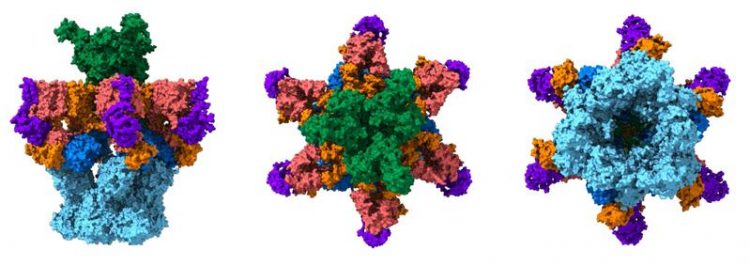Tuberculosis: New insights into the pathogen

Model of the secretion system of Mycobacterium tuberculosis. Sebastian Geibel
Tuberculosis is a highly contagious infectious disease that is typically spread through aerosols and mainly affects the lungs. According to the World Health Organization (WHO), an estimated 1.7 million people die from such an infection worldwide every year. In addition, a quarter of the world's population carries a form of tuberculosis that lies dormant without symptoms for a long time, but can break out eventually.
Nanomachines in the cell envelope
During infection Mycobacterium tuberculosis, the main causative agent of tuberculosis, secretes a large number of effector proteins through type VII secretion systems – small nanomachines which are composed of proteins that reside in the cell envelope. The effector proteins are specialized in fighting the immune defense or enable the uptake of nutrients to ensure the bacterial survival in the host. How these central secretion systems work, is still poorly understood.
Scientists from the Julius-Maximilians-Universität Würzburg (JMU) and the Spanish Cancer Research Centre CNIO (Centro Nacional de Investigaciones Oncológicas) have now succeeded in deciphering the molecular architecture of these nanomachines. Dr. Sebastian Geibel, who heads a research group at the Institute of Molecular Infection Biology funded by the Bavarian Elite Network and who is also affiliated with the Rudolf Virchow Centre of the JMU, was in charge of this work. The scientists have published their work in the current issue of the journal Nature.
Measurements at very low temperatures
Over the past five years, the research group of Dr. Geibel has worked intensively on the stable reconstitution of one of these secretion machines and the preparation of the sensitive sample for measurements on the cryo electron microscope, which requires the protein complexes to be shock frozen under defined conditions.
In collaboration with the research group of Oscar Llorca in Madrid, which computed three-dimensional maps of the protein complex using a sophisticated data processing strategy, the researchers from Würzburg were able to create a model of its molecular structure. The researchers were able to identify important elements of the nanomachine that form the transport pore as well as to locate elements that convert chemical energy into motion and thus drive the transport of effector proteins through the pore.
New approach for new drugs
The findings of the researchers lead to a deeper functional understanding of Type VII secretion systems. In times of rising resistance of mycobacteria to the antibiotics in use and no effective vaccination against tuberculosis in place, the researcher provide an important basis for the development of novel antibiotics that target the assembly or function of the type VII secretion systems.
Dr. Sebastian Geibel, T: +49 931 31-84590, sebastian.geibel@uni-wuerzburg.de
Architecture of the mycobacterial type VII secretion system. Nikolaos Famelis, Angel Rivera-Calzada, Gianluca Degliesposti, Maria Wingender, Nicole Mietrach, J. Mark Skehel, Rafael Fernandez-Leiro, Bettina Böttcher, Andreas Schlosser, Oscar Llorca & Sebastian Geibel. Nature, 9. October 2019, DOI 10.1038/s41586-019-1633-1.
Media Contact
More Information:
http://www.uni-wuerzburg.deAll latest news from the category: Life Sciences and Chemistry
Articles and reports from the Life Sciences and chemistry area deal with applied and basic research into modern biology, chemistry and human medicine.
Valuable information can be found on a range of life sciences fields including bacteriology, biochemistry, bionics, bioinformatics, biophysics, biotechnology, genetics, geobotany, human biology, marine biology, microbiology, molecular biology, cellular biology, zoology, bioinorganic chemistry, microchemistry and environmental chemistry.
Newest articles

High-energy-density aqueous battery based on halogen multi-electron transfer
Traditional non-aqueous lithium-ion batteries have a high energy density, but their safety is compromised due to the flammable organic electrolytes they utilize. Aqueous batteries use water as the solvent for…

First-ever combined heart pump and pig kidney transplant
…gives new hope to patient with terminal illness. Surgeons at NYU Langone Health performed the first-ever combined mechanical heart pump and gene-edited pig kidney transplant surgery in a 54-year-old woman…

Biophysics: Testing how well biomarkers work
LMU researchers have developed a method to determine how reliably target proteins can be labeled using super-resolution fluorescence microscopy. Modern microscopy techniques make it possible to examine the inner workings…





















